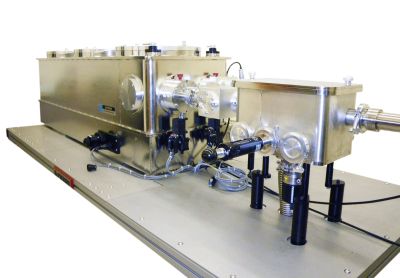
Vacuum Compatible High Resolution Czerny-Turner Monochromator
This instrument offers all of our great features and options: a wide variety of patented SNAP IN diffraction gratings, efficient broadband reflective coatings, and master polished optics. McPherson Czerny-Turner instruments with focal lengths greater than 0.67-meters allow you to use larger 120-mm x 140-mm grating or a 110-mm x 110-mm grating. The large grating offers almost 40% more area, achieving a faster f/number, and more throughput. In these models the grating can also rotate through an auxiliary 20° for extension of wavelength range. For the 1200-g/mm grating the high wavelength changes from 1300-nm to 1575-nm (more than 20% extra wavelength coverage!)
| Optical Design | McPherson Model 209 1.33-meter focal length f/9.4 Monochromator |
| Focal Length | 1.33-meter, Czerny Turner design Spectrometer with Patented "Snap-In" gratings |
| Aperture Ratio | 9.4 (11.6 with smaller grating) |
| Wavelength Range | refer to grating of interest for range, in extended position increase top limit 20% |
| Wavelength Accuracy | +/-0.05 nm (with 1200 G/mm grating) |
| Wavelength Reproducibility | +/- 0.005 nm (with 1200 G/mm grating) |
| Grating Size | 120 x 140-mm (or 110 x 110-mm) - Echelle gratings up to 220-mm wide |
| Slit Locations | Axial and lateral with optional extra entrance and exit port selection mirrors |
| Focal Plane | 50-mm maximum width, multiply dispersion by the width of your detector for range |
| Grating (G/mm) (others available) | 2400 | 1800 | 1200 | 600 | 300 | 150 | 75 | 20 |
| Wavelength Range from 185 nm to | 650nm | 860nm | 1.3um | 2.6um | 5.2um | 10.4um | 20.8um | 78um |
| Resolution (nm) at 313.1 nm | 0.005 | 0.007 | 0.01 | 0.02 | 0.04 | 0.08 | 0.16 | 0.60 |
| Dispersion (nm/mm) | 0.31 | 0.41 | 0.62 | 1.24 | 2.48 | 4.96 | 9.92 | 37.2 |
| First Order Littrow Blaze (nm) | 240nm | Holo | 250nm | 300nm | 750nm | 1.25um | 2.0um | 45um |
| 300nm | 300nm | 500nm | 1.0um | 2.5um | 3.0um | |||
| Holo | 500nm | 750nm | 3.0um | 4.0um | 8.0um | |||
| 750nm | 1.0um | 4.0um | 6.0um | 10.0um | ||||
| 1.0um | 1.85um | 8um | 12um | |||||